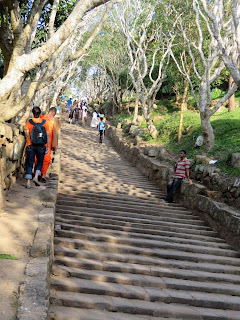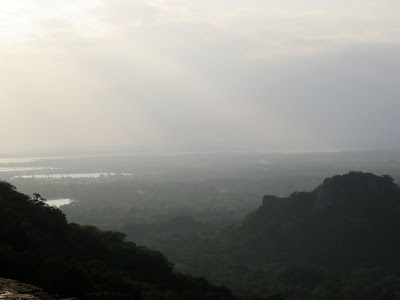
The tranquil Village of Mihintale is the birth place of Buddhism in Sri Lanka. The temple complex was about 13 km from the ancient capital city of Anuradhapura. The summit of Mihintale Hill was believed to be the site where the son of great King Ashoka, Mahinda Thera met and converted King Dewanampiyatissa (247-207BC)into a Buddhist Emperor in year 247 BC. Since then, Buddhism was favorably accepted by Sinhalese people and speedily spread and firmly established in the whole island.


Mahintale Monastery becomes focus of attraction once a year when it holds the celebration festival Poson Poya in the full moon night of June.


The 1840 steps that lead to the summit of Mihintale was constructed during the reign of King Bhathika Abbaya within years 22BC to 7 AD.








Across the wooded hills, there are shrines, stupas and meditation caves attracting crowds of devout pilgrims.



Kantaka Cetiya at the first terrace of Mihintale Hill built in 2nd BC, was one of the earliest monuments in Sri Lanka. It has four richly ornamented Vahalkadas shrines setting to face at cardinal points with horizontal rows of carvings of dwarfs friezes and elephants. Tall pillars containing carvings and holding a weathered lion at its top are at the other side of the walls.





The narrow steps near Kantaka Cetiya leads to the Maha Cetiya at the summit of Mihintale Hill.


The 153 feet high Maha Seya which was also known as Maha Cetiya or referred as Ambulu Dagaba in Pujavaliya stands at the summit of Mihintale Hill. It was built by King Mahadhatika Mahanage in 7 to 19 AD and was believed to have enshrined Lord Buddha's hair that was rounded at the middle of his forehead. The stupa was built over the exact spot where Mahinda Thera stood when he converted King Dewanampiyatissa (247-207BC)into a Buddhist disciple.


The shrine hall of the Maha Seya Stupa.


The Relic House


The summit of Mihintale Hill where Mahinda Thera approached King Dewanampiyatissa during his hunting.


Rock of Convocation was the site where Mahinda Thera delivered his first sermon.






The Black Water Pond Kaludiya Pokuna was a man-made pond that believed to be the water source supplied to monastery. It exist since 10th to 11th century. Few temple ruins including a little structure with facade and roof built into a natural hanging rock, were found near the area.



The enormous boulder was a natural Kuti where Mahinda Thera lived. The rock served as a roof that sheltered The Sage from rain and shine.


The natural resting home of the Sage was accessible from a winding path through a woodland.


The meditation and resting bed of Mahinda Thera was a huge and smooth stone slab.


The natural kuti faced a vast horizon of plateau and mountainous ranges.


View of surrounding plateau from the summit of Mihintale Hill







The two stone slabs at the foot of Mihintale monastery were erected in 10th century when Annuradhapura was still the capital city of the State, by orders of King Mahinda IV (956-972). The inscriptions therein provide information of monastic administrative rules and regulations pertaining to Sangha community, the works involved with vihara, the relic house and other monastic structures. The intervention of State wages and allowances for Vihara's employees were also inscribed on the slabs. The two slabs are of high historical value.


The ruins at the foot of Mahintale Hill also include remnants of a medical center known as Vejja Sala Hospital which was dated back to 3rd century.


No comments:
Post a Comment